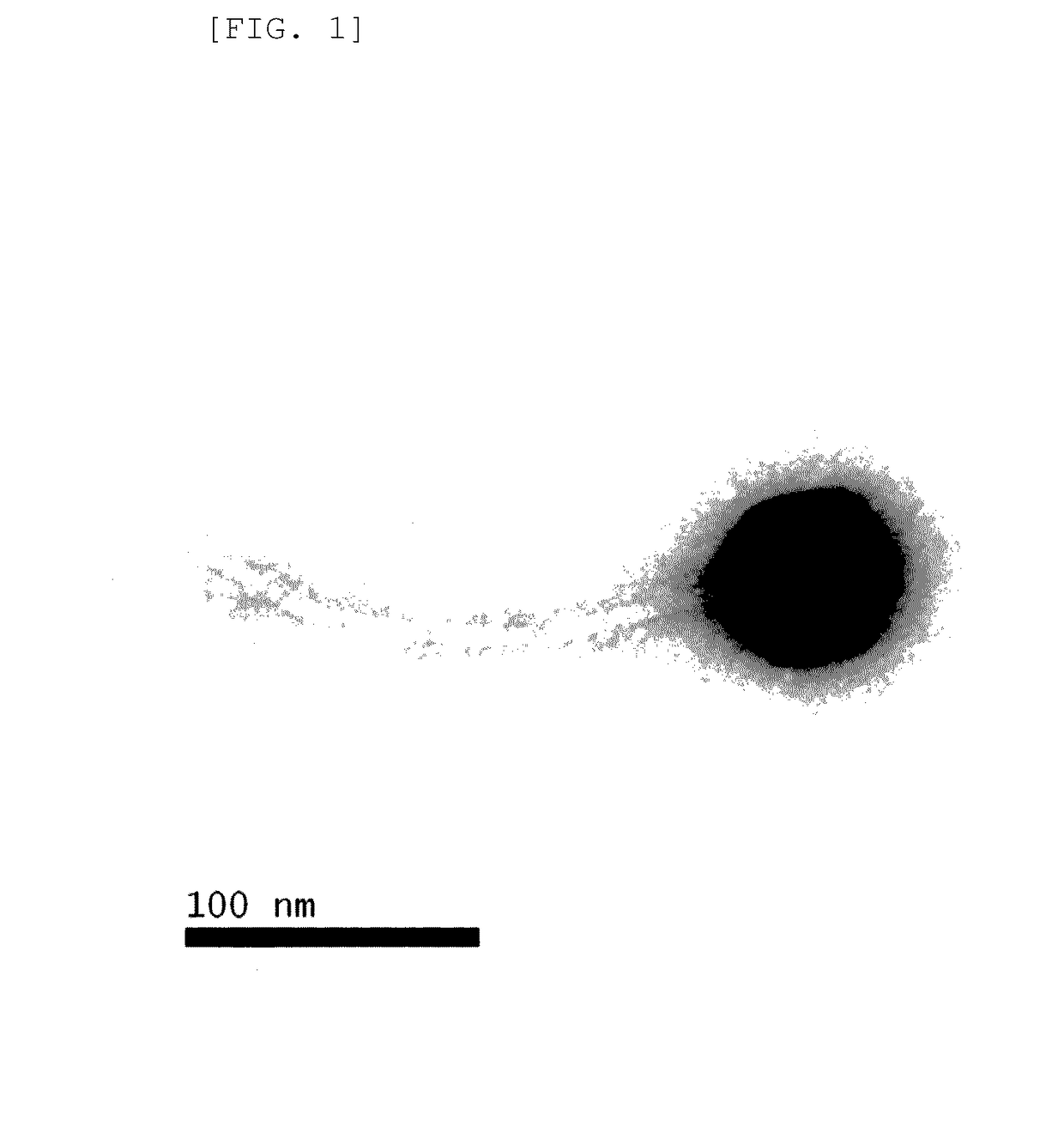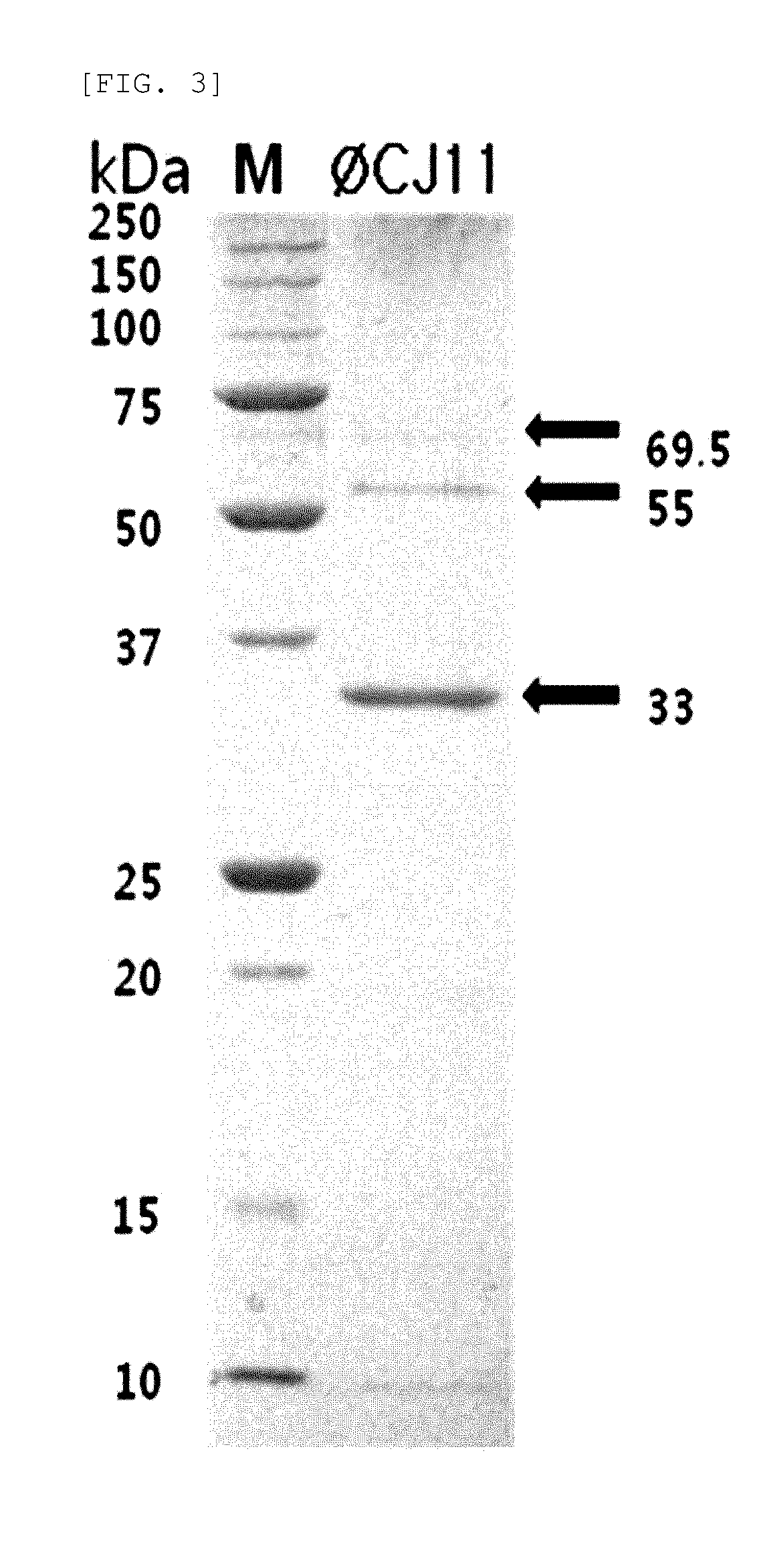Bacteriophage and antibacterial composition comprising the same
a technology of bacteriophage and composition, which is applied in the direction of viruses/bacteriophages, antibacterial agents, biocide, etc., can solve the problems of jung-bok lee infection, damage to farmers and consumers, and skin discoloration, etc., and achieve excellent acid- and heat-resistance and desiccation tolerance, specific bactericidal
- Summary
- Abstract
- Description
- Claims
- Application Information
AI Technical Summary
Benefits of technology
Problems solved by technology
Method used
Image
Examples
example 1-1
ge Screening and Single
Bacteriophage Isolation
[0059]50 mL of sample from swinery and sewage effluent was transferred to a centrifuge tube, and centrifuged at 4000 rpm for 10 minutes. Then, the supernatant was filtered using a 0.45 μm filter. 18 mL of sample filtrate was mixed with 150 μl of Salmonella choleraesuis (“SC”) shaking culture medium (OD600=2) and 2 mL of 10× Luria-Bertani medium (tryptone 10 g / L, yeast extract 5 g / L and NaCl 10 g / L: LB medium). The mixture was cultured at 37° C. for 18 hours, and the culture medium was centrifuged at 4000 rpm for 10 minutes. The supernatant was filtered using a 0.2 μm filter. 3 mL of 0.7% agar (w / v) and 150 μl of SC shaking culture medium (OD600=2) were mixed, and plated onto LB plate (“top-agar”), and allowed to solidify. 10 μl of the culture filtrate was spread thereon, and cultured for 18 hours at 37° C., and the titration of phage lysate was performed on the top-agar, called soft agar overlay method.
[0060]The sample culture medium con...
example 1-2
Batches of Bacteriophage
[0061]The selected bacteriophages were cultured in large quantities using SC. SC was shaking-cultured, and an aliquot of 1.5×1010 cfu (colony forming units) was centrifuged at 4000 rpm for 10 minutes, and the pellet was resuspended in 4 ml of SM solution. The bacteriophage of 9.0×108 PFU (plaque forming unit) was inoculated thereto (MOI: multiplicity of infection=0.001), and left at 37° C. for 20 minutes. The solution was inoculated into 150 ml of LB media, and cultured at 37° C. for 5 hours. Chloroform was added to a final volume of 1%, and the culture solution was shaken for 20 minutes. DNase I and RNase A were added to a final concentration of 1 μg / ml, respectively. The solution was left at 37° C. for 30 minutes. NaCl and PEG (polyethylene glycol) were added to a final concentration of 1 M and 10% (w / v), respectively and left at 4° C. for an additional 3 hours. The solution was centrifuged at 4° C. and 12,000 rpm for 20 minutes to discard the supernatant. ...
example 3
y of φCJ11
[0064]The purified ΦCJ11 was diluted in the SM buffer solution, and then mounted on a copper grid, stained with 2% uranyl acetate for 3 to 5 seconds, and dried. Examination under a transmission electron microscope (LIBRA 120, Carl Zeiss transmission electron Microscope, 80 kV, magnification of ×120,000×200,000) was performed (FIG. 1). FIG. 1 is an electron microscopy photograph of ΦCJ11. As shown in FIG. 1, it was found that the purified ΦCJ11 belongs to the family Siphoviridae of morphotype B1, characterized by an isometric capsid and a long non-contractile tail.
PUM
| Property | Measurement | Unit |
|---|---|---|
| temperature | aaaaa | aaaaa |
| pH | aaaaa | aaaaa |
| pH | aaaaa | aaaaa |
Abstract
Description
Claims
Application Information
 Login to View More
Login to View More - R&D
- Intellectual Property
- Life Sciences
- Materials
- Tech Scout
- Unparalleled Data Quality
- Higher Quality Content
- 60% Fewer Hallucinations
Browse by: Latest US Patents, China's latest patents, Technical Efficacy Thesaurus, Application Domain, Technology Topic, Popular Technical Reports.
© 2025 PatSnap. All rights reserved.Legal|Privacy policy|Modern Slavery Act Transparency Statement|Sitemap|About US| Contact US: help@patsnap.com



